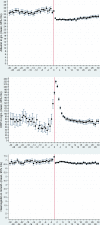Hypoalbuminaemia as a marker of trans-capillary leakage in community-acquired bacteraemia patients
- PMID: 29457576
- PMCID: PMC9134564
- DOI: 10.1017/S0950268818000274
Hypoalbuminaemia as a marker of trans-capillary leakage in community-acquired bacteraemia patients
Abstract
Community-acquired bacteraemia patients (n = 2472), Denmark, 2000-2008. Albumin, C-reactive protein (CRP) and haemoglobin (Hb) measured 2000-2010. We assessed daily mean levels of albumin, CRP and Hb from 30 days before to 30 days after bacteraemia and correlations between albumin vs. CRP and albumin vs. Hb. In linear regression models, we evaluated the contribution of CRP, Hb, chronic and acute variables to the albumin level variations. The mean albumin level (33.6 g/l) was steady before day 1, declined to 29.3 g/l on day 1 with little increase afterward. The mean CRP increased from day -5, peaked on day 1 and declined thereafter. The mean Hb level was fairly constant during days -30/30. Albumin was inversely (R range, - 0.18/-0.47, P < 10-4) correlated with the CRP level and positively (R = 0.17-0.46, P < 10-4) correlated with the HB level. In most models, CRP was the first variable that contributed to the albumin variations, 34-70% of the full model. The sudden decrease of albumin levels, without sudden fluctuations of CRP or Hb, indicated that hypoalbuminaemia was a marker of trans-capillary leakage.
Keywords: Bloodstream infections; Septicaemia.
Conflict of interest statement
None.
Figures



Similar articles
-
C-reactive protein and albumin kinetics before community-acquired bloodstream infections - a Danish population-based cohort study.Epidemiol Infect. 2020 Feb 26;148:e38. doi: 10.1017/S0950268820000291. Epidemiol Infect. 2020. PMID: 32100658 Free PMC article.
-
Longitudinal trajectory patterns of plasma albumin and C-reactive protein levels around diagnosis, relapse, bacteraemia, and death of acute myeloid leukaemia patients.BMC Cancer. 2020 Mar 24;20(1):249. doi: 10.1186/s12885-020-06754-z. BMC Cancer. 2020. PMID: 32209087 Free PMC article.
-
Association between Hypoalbuminaemia and Mortality in Patients with Community-Acquired Bacteraemia Is Primarily Related to Acute Disorders.PLoS One. 2016 Sep 9;11(9):e0160466. doi: 10.1371/journal.pone.0160466. eCollection 2016. PLoS One. 2016. PMID: 27611431 Free PMC article.
-
Longitudinal and cross-sectional effects of C-reactive protein, equilibrated normalized protein catabolic rate, and serum bicarbonate on creatinine and albumin levels in dialysis patients.Am J Kidney Dis. 2003 Dec;42(6):1200-11. doi: 10.1053/j.ajkd.2003.08.021. Am J Kidney Dis. 2003. PMID: 14655192
-
C-reactive protein and albumin kinetics after antibiotic therapy in community-acquired bloodstream infection.Int J Infect Dis. 2020 Jun;95:50-58. doi: 10.1016/j.ijid.2020.03.063. Epub 2020 Apr 3. Int J Infect Dis. 2020. PMID: 32251802
Cited by
-
Systemic inflammatory biomarkers and somatic cell count in dairy cows with subclinical mastitis.Vet Anim Sci. 2021 Jan 8;11:100165. doi: 10.1016/j.vas.2021.100165. eCollection 2021 Mar. Vet Anim Sci. 2021. PMID: 33665474 Free PMC article.
-
C-reactive protein and albumin kinetics before community-acquired bloodstream infections - a Danish population-based cohort study.Epidemiol Infect. 2020 Feb 26;148:e38. doi: 10.1017/S0950268820000291. Epidemiol Infect. 2020. PMID: 32100658 Free PMC article.
-
Longitudinal trajectory patterns of plasma albumin and C-reactive protein levels around diagnosis, relapse, bacteraemia, and death of acute myeloid leukaemia patients.BMC Cancer. 2020 Mar 24;20(1):249. doi: 10.1186/s12885-020-06754-z. BMC Cancer. 2020. PMID: 32209087 Free PMC article.
-
Hypoalbuminemia as Surrogate and Culprit of Infections.Int J Mol Sci. 2021 Apr 26;22(9):4496. doi: 10.3390/ijms22094496. Int J Mol Sci. 2021. PMID: 33925831 Free PMC article. Review.
-
Evaluation of Albumin Kinetics in Critically Ill Patients With Coronavirus Disease 2019 Compared to Those With Sepsis-Induced Acute Respiratory Distress Syndrome.Crit Care Explor. 2021 Dec 2;3(12):e0589. doi: 10.1097/CCE.0000000000000589. eCollection 2021 Dec. Crit Care Explor. 2021. PMID: 34984341 Free PMC article.
References
-
- Rothschild MA, Oratz M and Schreiber SS (1988) Serum albumin. Hepatology 8, 385–401. - PubMed
-
- Doweiko JP and Nompleggi DJ (1991) The role of albumin in human physiology and pathophysiology, Part III: Albumin and disease states. Journal of Parenteral and Enteral Nutrition 15, 476–483. - PubMed
-
- Doweiko JP and Nompleggi DJ (1991) Role of albumin in human physiology and pathophysiology. Journal of Parenteral and Enteral Nutrition 15, 207–211. - PubMed
-
- Hansson LO, Hedlund JU and Ortqvist AB (1997) Sequential changes of inflammatory and nutritional markers in patients with community-acquired pneumonia. Scandinavian Journal of Clinical and Laboratory Investigation 57, 111–118. - PubMed
MeSH terms
Substances
LinkOut - more resources
Full Text Sources
Other Literature Sources
Research Materials
Miscellaneous

